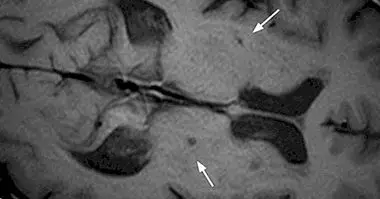Neuroleptic malignant syndrome: symptoms, causes and treatment
The use of antipsychotic medication within the scope of mental health is one of the most used remedies when intervening in a patient with some type of disorder or illness in which there are a series of psychotic symptoms. Also, it is increasingly common prescription for changes in mood and personality disorders.
However, sometimes the consumption of this antipsychotic medication is associated with certain side effects, which interfere with the proper functioning of the central nervous system. A strange disease associated with the effects of this medication is the neuroleptic malignant syndrome , which can lead to numerous complications in the body and even death.
Definition of neuroleptic malignant syndrome
Neuroleptic malignant syndrome is a rare condition caused by an adverse response to the effects of antipsychotic medication in the first place, or other drugs associated in the second. This response may be caused by the action of the medication or by abrupt withdrawal of it.
This unusual syndrome is distinguished by complications such as dysautonomia, elevation of body temperature, changes in the state of consciousness and death in those cases in which there is no intervention in time.
This syndrome has to affect to a greater extent male and young people who are administered a neuroleptic prolonged release . As well as in Parkinson's patients who are moderate in dosage or the usual dopaminergic treatment is canceled.
Symptomatology
Symptoms associated with neuroleptic malignant syndrome tend to appear during the first three days after the patient begins treatment . These symptoms begin with the appearance of anxiety sensation which precedes the alterations of the state of consciousness.
The most characteristic manifestations of this syndrome are hyperthermia and muscular rigidity. With regard to hyperthermia, the person can suffer fevers of between 38.5º and more than 40º, which is considered an essential requirement for the diagnosis of this condition.
On the other hand, muscle rigidity can cause complications such as dysarthria or difficulty in articulating sounds, swallowing problems and excessive secretion of saliva. As well as hypoventilation and asphyxia or breathing difficulties.
Other symptoms found in person suffering from this syndrome include:
- Tachycardia
- Diaphoresis or excessive sweating
- Cutaneous pallor
- Incontinence
- Hypertension
- Obesity, dullness or coma
- Alteration of reflexes
- Generalized seizures
- Tremors
- Kidney failure
Causes of this syndrome
The main theories in the study of neuroleptic malignant syndrome point to the different effects that neuroleptics can have on the correct articulation of the pyramidal system and on the hypothalamus.
The hypothesis most supported by the scientific and medical community proposes that a decrease in the dopaminergic activity of the central nervous system can interfere in the correct functioning of the basal nuclei and the hypothalamus.
- The basis of this theory is based on two justifications:
- The syndrome originates after the administration of antidopaminergic medication
- Dopamine is a neurotransmitter that mediates pathologies in the central nervous system that include alterations in muscle tone and thermoregulation
Likewise, Other symptoms such as muscle stiffness, slow movements, mutism and jerking or palpitations are likely to be caused by an instability or alteration of the dopaminergic system in the hypothalamus.
Finally, it has been observed that the administration of dopamine agonist drugs, such as bromocriptine, are effective in reducing the symptoms associated with neuroleptic malignant syndrome.
Diagnosis and differential diagnosis
There are a series of firmly established criteria for the diagnosis of this disorder. These criteria are classified into major and minor and the person must meet, at least, the three major criteria, or two major and four minor.
Major criteria
The major criteria include hyperthermia, muscle tension, increase in the enzyme creatine kinase (CPK).
Minor criteria
Tachycardia, abnormal blood pressure, increased respiratory rate, changes in consciousness, sweating and leukocytosis.
However, there are discrepancies within the medical community when it comes to pointing out the increase in creatine kinase (CPK) as a criterion of greater importance.From this point of view, a series of alternative diagnostic criteria have been designed according to which, for an effective diagnosis, the person must suffer from these three symptoms:
- Hyperthermia or elevation of the temperature above 37.5º, without there being another pathology that justifies it.
- Severe extrapyramidal manifestations such as muscle tension, dysphagia, excessive secretion of saliva, alterations in eye movement, arching of the spine or grinding of teeth.
- Depression of the autonomic nervous system
Since the mortality potential of the neuroleptic malignant syndrome is considerably high, It is necessary to rule out any other type of condition or disease, as well as current in the fastest possible way .
For the differential diagnosis, the possibility that the person suffers any of the following alterations should be ruled out:
Symptoms caused by the development of an infection in the central nervous system
- Lethal catatonia
- Malignant hyperthermia produced by anesthetic medication or by muscle relaxants
- Heatstroke
- Atropinism or overdose poisoning of anticholinergic medication
Treatment
In cases in which the syndrome is produced by the effects of neuroleptics will be necessary, first of all, withdraw medication and provide support and relief care both to lower body temperature and to reverse arterial hypotension by restoring fluids and the use of vasoactive medications.
In most cases in which the syndrome is detected in time the intervention of support is effective and it is enough for the syndrome to refer and to lead the patient to a recovery without any type of sequela .
- The reference medication used to treat neuroleptic malignant syndrome includes:
- Anticholinergic drugs to treat extrapyramidal symptoms.
- Dantrolene sodium to relax the muscles and end muscle tension
- Benzodiazepines to reduce anxiety and lower levels of agitation
- Clozapine to restore neuroleptic medication
Prognosis and possible complications
At the moment when the medication is suspended and the treatment for the neuroleptic malignant syndrome begins, the evolution of the symptoms should be positive, that is, the patient should progressively improve.
However, there are a relatively frequent series of complications that could hinder this recovery. These difficulties include:
- Renal insufficiency
- Respiratory failure or pulmonary embolism
- Setbacks such as liver failure, heart failure or seizures
Despite the severity of the symptoms and possible complications the person can get over the disease as long as it is treated in time . Otherwise, the probability of death increases considerably, being the most common causes of death: heart failure, pneumonia, pulmonary embolism, sepsis and hepatorenal failure.



















